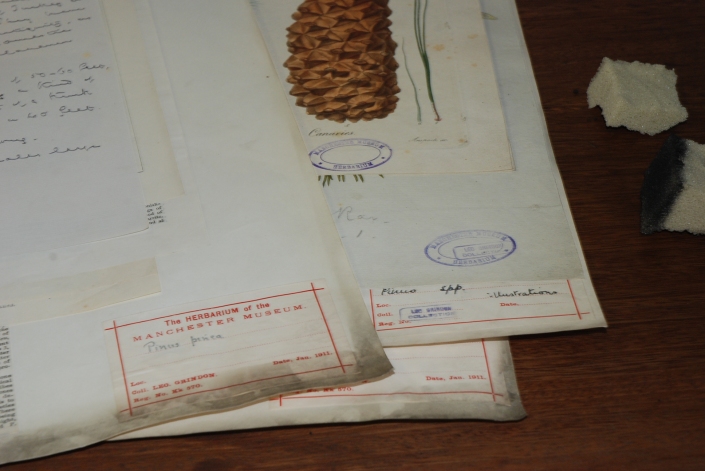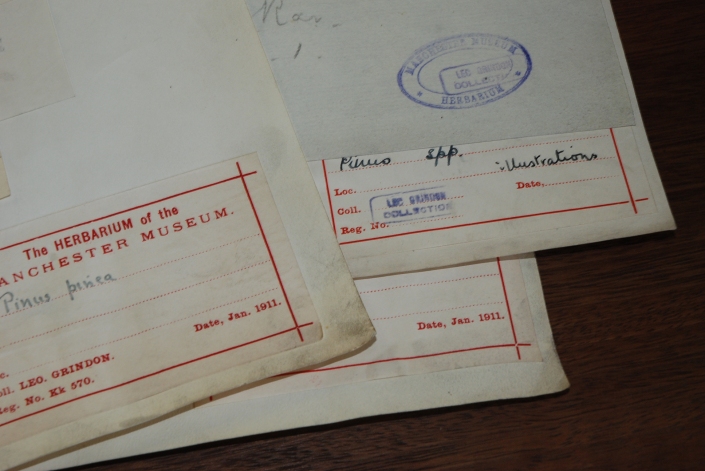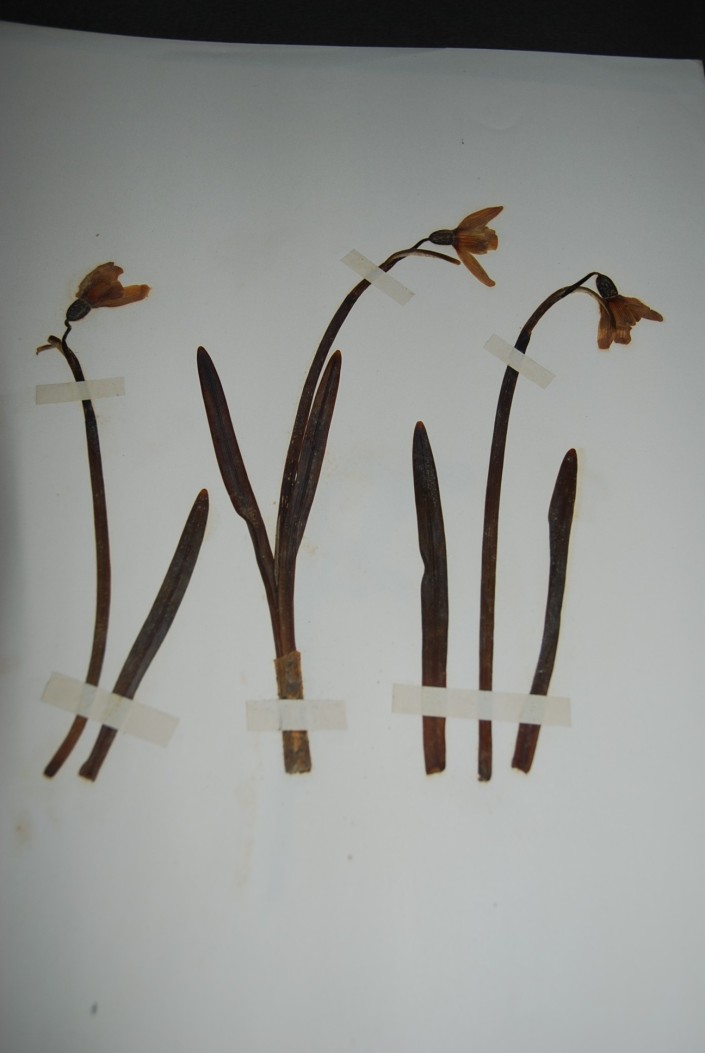Latest Event Updates
Safely stored?
Following an enquiry, I’ve looked out some thought-provoking specimens this week. I spent a quite melancholy afternoon searching our database with plant names listed as extinct or extinct in the wild in the IUCN Red List of Threatened Species. Here are a few of them:

Bromus interruptus (interrupted brome) was an agricultural weed found in southern and eastern England, but it became extinct as agricultural practices changed. The species is thought to have originated in Britain in the 19th century, but it was no longer found growing wild by 1972. However, this species is counted as extinct in the wild as seeds were collected from the last population and were cultivated in botanic gardens. Subsequently it has been re-introduced to the english countryside in the hope that it can re-establish itself.


This pretty red seaweed, however, is thought to be fully extinct. Vanvoorstia bennettiana (Bennett’s seaweed) has only been collected twice, once in 1855 and again 1886 from two different locations in and around Sydney Harbour. Despite extensive searches, this species seems to be extinct, perhaps because of disturbance and pollution of its habitat.


Finally, this is Melicope cruciata (cross bearing pelea), a tree in the citrus family which only ever grew on the Hawaiian island of Kauai. Rather poignantly, these seeds have been labelled and stored since their collection in 1895. This week, scientists from Russia have reported that the have successfully regenerated plants from 33,000 year-old seeds of Silene stenophylla which were found buried in the Siberian permafrost. However, I imagine that our cross-bearing pelea seeds have experienced much more variable conditions over their 117 year storage and are unlikely to still be viable.
The allotment in February
Out on the allotment there has been snow, frost, wind and rain and so not much has changed since January. However, while everything’s quiet on the plant front, the allotment has welcomed lots of visitors to the museum during half-term week. Look how dry the path to the front door is after so many feet have passed by! The allotment volunteers have also been busy behind-the-scenes, planning the year ahead and exciting new developments for the shed.
Climate Change Question Time
 This is the tiny Scottish primrose (Primula scotia) and these lovely specimens still have a hint of the purple colour of the fresh flowers. They are Scottish endemics (so they don’t grow anywhere else in the world) and even then they are only found on the far north-eastern coasts along north-west Sutherland, Caithness and Orkney. This species is very particular about what it needs to thrive e.g. for the grass around them to be short (but not over-grazed), to be at a coastal site (but not subject to really severe storms) and where the soil is moist (but well-drained).
This is the tiny Scottish primrose (Primula scotia) and these lovely specimens still have a hint of the purple colour of the fresh flowers. They are Scottish endemics (so they don’t grow anywhere else in the world) and even then they are only found on the far north-eastern coasts along north-west Sutherland, Caithness and Orkney. This species is very particular about what it needs to thrive e.g. for the grass around them to be short (but not over-grazed), to be at a coastal site (but not subject to really severe storms) and where the soil is moist (but well-drained).
With a limited range and Goldilocks-style habitat preferences, this is the type of plant which which could suffer as a result of global climate change. Flowering and seed-set would suffer if the Scottish summers become either to hot or too cold, and violent winter storms could seriously damage currently healthy populations.
If you are interested in climate change, both what effects it may have and what we can do about it, then you may be interested to pose your questions to a panel of experts at The Manchester Museum’s Climate Change Question Time on 23rd February, 2012.
Winter trees for Urban Naturalist
This afternoon I’ve been looking out specimens to show at tomorrows Urban Naturalists event on winter tree identification. It’s harder than you might think to find objects to show from the collection. Manchester’s botanists really liked leaves and flowers (which don’t really give the right feel for January) and curiosities (looking at abnormal growths probably won’t help much with identifying a healthy tree).
Luckily they were also interested in economic botany and so we’ve also got plenty of timber. These microscope slides are lovely, but I think they’ll have to wait for another event. This weekend, it’s time for the logs to go out on display.
Rusholme Village
 Last week I went to a really interesting talk by Anne Tucker from the Friends of Platt Fields on William Royle, the man responsible for persuading the city to council open the estate of Platt Hall as a public park in 1910. Alongside the busy bus corridor of Oxford Road and surrounded by the dense suburbs of Rusholme, Moss Side and Fallowfield, Platt Fields Park does feel like a piece of countryside which has been preserved in south Manchester.
Last week I went to a really interesting talk by Anne Tucker from the Friends of Platt Fields on William Royle, the man responsible for persuading the city to council open the estate of Platt Hall as a public park in 1910. Alongside the busy bus corridor of Oxford Road and surrounded by the dense suburbs of Rusholme, Moss Side and Fallowfield, Platt Fields Park does feel like a piece of countryside which has been preserved in south Manchester.
William Royle was concered about the spread of the city of Manchester swamping his village, and he wasn’t the only Manchester resident who was watching the rapid changes to the city. In the preface to his book of Manchester walks (1882), Leo Grindon comments “Neighbourhoods once familiar as delightful rural solitudes, are now covered with houses, and densely crowded with population; the pleasant field-paths we trod in our youth have disappeared, and in their stead are long lines of pavement, lighted by gas and paced by policemen…….No longer than fifteen years ago (i.e. in 1840) ….on the very spot where Platt Chuch now lifts its tall and graceful spire, there was a large pond filled with the Stratiotes, or water aloe.”
The plant referred to is Stratiotes aloides (now more often known as water soldier) which grows in healthy ponds. This specimen from our British collection was collected from Rusholme in 1849 by Joseph Sidebotham – a good friend of Leo Grindon. Did it come from that missing pond underneath Platt church? I guess we’ll never know and it shows that there is no such thing as too much information on a specimen label.
The event was organised by Cafe Historique and if you’re interested in local history look out for the next talk on Manchester’s Arab communities being hosted by the museum this coming Saturday.
Cleaning & Fibonacci pinecones

These herbarium sheets have very dirty edges and I am cleaning them with chemical sponge, a conservation tool sometimes used for cleaning up fire damaged books.

And one of the illustrations:
- illustration of Pinus mughus, Swiss Mountain Pine
Woodlands
Today Plantlife has released a new report into English woodlands which are biologically diverse and ecological important ecosystems. However, despite having more woodlands than we did 20 years ago, many woodland species are still declining. This new report suggests that woodlands could be better managed to increase biodiversity e.g. through more extensive use of coppicing. You can read more reported in the media here: http://gu.com/p/34ytj or read the findings in the report on the Plantlife website: http://www.plantlife.org.uk/about_us/news_press/forestry_recommissioned
Model changes
At the beginning of January this year, the annual grass species Brachypodium distachyon was split into three separate species which were described and published in the Annals of Botany. It had been known for some time that there were variants of B. distachyon which had different numbers of chromosomes but now an international group of scientists has identified them as distinct species.
Those with 10 chromosomes will keep the name B. distachyon, those with 20 chromosomes are named B. stacei and those with 30 chromosomes originated as a cross between the other two species and are named B. hybridium. The species B. stacei is found on the Balearic Islands and is named in honour of Clive A. Stace (Emeritus Professor of Botany at the University of Leicester) who started the research into the evolutionary relationships of plants in the Brachypodium genus. http://www2.le.ac.uk/news/blog/2012/january/the-naming-of-names-new-grass-species-honours-emeritus-professor
This little plant is interesting as it is a model species used by research scientists for experiments into topics such as grain filling. Brachypodium distachyon is small and easy to grow, has a short life-cycle and a small and fully sequenced genome. This makes it a lot easier to work with than related and economically important grasses such as wheat and switchgrass. The model plant most often used for research into broad-leaved plants is called Arabidopsis thaliana and there’s a picture of it on this previous blog post: https://herbologymanchester.wordpress.com/2010/03/16/gene-discovery-to-increase-biomass-needed-for-green-fuel/

















